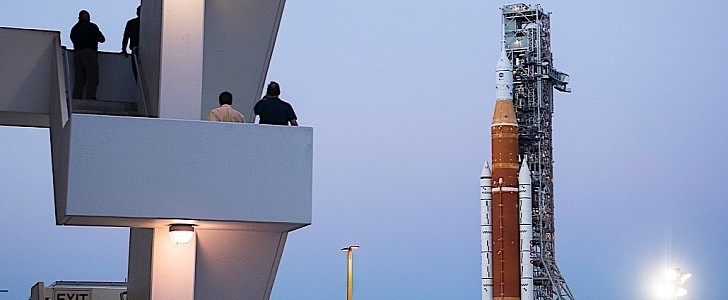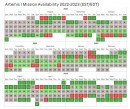To most of us modern humans, rocket launches to other realms out there in the sky may look a bit ordinary. Accustomed to such sights for more than half a century now, we often tend to forget all the work and complicated math that go into making every single launch a success.
This year, the world is bracing for two important space missions. First up, and somewhat less crucial in the grand scheme of things, is the first orbital flight of SpaceX Starship. The second is the mission that should kickstart the new American Moon exploration program, Artemis.
Called Artemis I, the mission’s exact launch date is at the moment unknown, and given the technical problems of the Space Launch System (SLS) rocket, pretty uncertain. But it will happen, and NASA took advantage of the slow news cycle concerning the SLS, the Orion spaceship it carries, and their mission, to highlight what it takes to put something on the right course to the Moon. And we also got some potential launch dates to go.
The first thing Artemis I should take into account when deciding when to lift off is the Moon's position in the lunar cycle at the time of launch. Because the current upper stage of the rocket is not the final and best version of itself, the Moon must be in the right position for the rocket to achieve the right burn for a distant retrograde orbit injection. Future iterations of the SLS, says NASA, should be able to launch no matter when, but subject to the intended orbit.
Then, NASA must do the math and make sure “Orion is not in darkness for more than 90 minutes at a time.” If it is, its solar panels will become quite useless, and with no power there is no mission. To avoid that, the agency is looking for the dates that will not send the spaceship into extended eclipses as it moves between here and there. For that to happen, rocket scientists must take into account the position and path of the Earth, Moon, and Sun along the planned mission trajectory.
Third, the launch date must make possible a skip entry return back to Earth. That’s a new way of bringing something down from a trip to space, and will require the capsule to “dip into the upper part of Earth’s atmosphere and use that atmosphere, along with the lift of the capsule, to skip back out of the atmosphere, then reenter for final descent under parachutes and splashdown.” This way of doing things should ensure the lowering of aerodynamic breaking loads the astronauts seated inside upcoming Artemis missions will experience.
The launch date also influences the return date for Artemis I, and NASA must also take that into account, as it plans to bring Orion back in daylight, to better “assist recovery personnel when they locate, secure, and retrieve the spacecraft from the Pacific Ocean.”
With all that in mind, NASA identified six launch windows for Artemis I in the coming months. They are listed below:
So, provided everything goes well with the planned wet dress rehearsal test, this is when we are to expect the new age of space exploration to begin.
Called Artemis I, the mission’s exact launch date is at the moment unknown, and given the technical problems of the Space Launch System (SLS) rocket, pretty uncertain. But it will happen, and NASA took advantage of the slow news cycle concerning the SLS, the Orion spaceship it carries, and their mission, to highlight what it takes to put something on the right course to the Moon. And we also got some potential launch dates to go.
The first thing Artemis I should take into account when deciding when to lift off is the Moon's position in the lunar cycle at the time of launch. Because the current upper stage of the rocket is not the final and best version of itself, the Moon must be in the right position for the rocket to achieve the right burn for a distant retrograde orbit injection. Future iterations of the SLS, says NASA, should be able to launch no matter when, but subject to the intended orbit.
Then, NASA must do the math and make sure “Orion is not in darkness for more than 90 minutes at a time.” If it is, its solar panels will become quite useless, and with no power there is no mission. To avoid that, the agency is looking for the dates that will not send the spaceship into extended eclipses as it moves between here and there. For that to happen, rocket scientists must take into account the position and path of the Earth, Moon, and Sun along the planned mission trajectory.
The launch date also influences the return date for Artemis I, and NASA must also take that into account, as it plans to bring Orion back in daylight, to better “assist recovery personnel when they locate, secure, and retrieve the spacecraft from the Pacific Ocean.”
With all that in mind, NASA identified six launch windows for Artemis I in the coming months. They are listed below:
- Between July 26 and August 10, there will be 13 opportunities, except on August 1, 2, and 6.
- Between August 23 and September 6, there are 12 potential dates, but not on August 30, 31, and September 1.
- From September 20 to October 4, 14 opportunities line up, except on September 29.
- In the October 17 – October 31 timeframe, 11 launch opportunities occur, but not on October 24, 25, 26, and 28.
- From November 12 to November 27 there are 12 chances, except on November 20, 21, and 26.
- The final 11 right moments for the kickstart of the Artemis program this year occur between December 9 and December 23, except on December 10, 14, 18, and 23.
So, provided everything goes well with the planned wet dress rehearsal test, this is when we are to expect the new age of space exploration to begin.



















